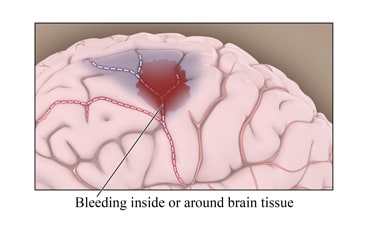What is a hemorrhagic stroke?

When you have a hemorrhagic (say "heh-muh-RA-jick") stroke, it means that a blood vessel in the brain has burst open or has started to leak. When the blood spills into the space inside and around the brain, it damages nearby nerve cells.
This is different from an ischemic (say "iss-KEE-mick") stroke, which happens when a blood clot blocks a blood vessel in the brain.
The brain damage from a stroke starts within minutes. The part of the body controlled by the damaged area of the brain cannot work properly. Quick treatment can help limit damage to the brain and make recovery more likely.
The problems someone has after a stroke depend on what part of the brain was affected and how much damage the stroke caused. A stroke may affect movement and senses, speech, memory, thinking, or emotions. Stroke rehabilitation, which includes training and therapy, can help people recover.
What are the symptoms?
The most common symptom of hemorrhagic stroke is a sudden and severe headache. Many people describe it as "the worst headache of my life."
If you have any stroke symptoms, call 911 or other emergency services right away.
- Stroke symptoms include:
- Sudden numbness, tingling, weakness, or loss of movement in your face, arm, or leg, especially on only one side of your body.
- Sudden vision changes.
- Sudden trouble speaking.
- Sudden confusion or trouble understanding simple statements.
- Sudden problems with walking or balance.
- A sudden, severe headache that is different from past headaches.
- Fainting.
- A seizure.
Other symptoms include:
- Nausea and vomiting.
- Neck stiffness.
- Dizziness.
- Changes in mental state, such as irritability or confusion.
What causes a hemorrhagic stroke?
A hemorrhagic stroke occurs when weakened blood vessels burst or leak. Causes of weakened blood vessels in the brain include:
- A brain aneurysm. This is a bulging, weak part of a blood vessel. It can put pressure on nerves, or it can bleed or break open (rupture).
- A brain AVM. This is an abnormal knot of weak blood vessels that some people are born with.
- Head injury.
- Chronic uncontrolled high blood pressure. Blood pressure that is too high over the long term increases your risk for stroke.
- Very high blood pressure. Very high blood pressure that comes on suddenly is dangerous. It is a medical emergency.
Other causes of a hemorrhagic stroke are anticoagulant and antiplatelet medicines. These medicines can cause bleeding in the brain. These medicines, also called blood thinners, increase the time it takes for a blood clot to form.
How is hemorrhagic stroke treated?
Emergency treatment is done to stop bleeding and prevent damage to the brain. You may get medicine to stop the bleeding and manage blood pressure. Surgery may be done to repair an aneurysm or remove blood from inside the brain. You may have stroke rehab to help you recover and regain any lost abilities.
How can you help prevent another stroke?
- Work with your doctor to manage other health problems, such as high blood pressure.
- Be safe with medicines. Take your medicine exactly as prescribed. Contact your doctor if you think you are having a problem with your medicine.
- Have a heart-healthy lifestyle.
- Don't smoke, vape, or use other tobacco or nicotine products. If you need help quitting, talk to your doctor about quit programs and medicines. These can increase your chances of quitting for good. Also avoid secondhand smoke and the aerosol mist from vaping.
- Limit alcohol to 2 drinks a day for men and 1 drink a day for women.
- Be active. Ask your doctor what type and level of activity is safe for you.
- Eat heart-healthy foods, like fruits, vegetables, lean meat, poultry, fish, or whole grains.
- Stay at a weight that's healthy for you. Talk to your doctor if you need help losing weight.
- Get vaccinated against COVID-19, the flu, and pneumonia.
- If you think you may have a problem with alcohol or drug use, talk to your doctor.
Follow-up care is a key part of your treatment and safety. Be sure to make and go to all appointments, and call your doctor if you are having problems. It's also a good idea to know your test results and keep a list of the medicines you take.
Where can you learn more?
Go to http://www.healthwise.net/patientEd
Enter R416 in the search box to learn more about "Learning About a Hemorrhagic Stroke".
Current as of: October 2, 2025
Author: Ignite Healthwise, LLC Staff
Clinical Review Board
All Ignite Healthwise, LLC education is reviewed by a team that includes physicians, nurses, advanced practitioners, registered dieticians, and other healthcare professionals.

